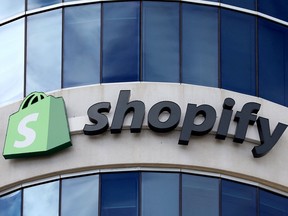Two and a half months ago, Shopify Inc. president Harley Finkelstein said the company wasn’t planning any more layoffs after slashing 10 per cent of its workforce the previous summer. Yet, following first-quarter earnings on May 4, Shopify announced it was cutting 20 per cent, or more than 2,000, staffers as it sheds a strategic part of the business once meant to expand the company beyond digital e-commerce products.
Business
‘Some of you will leave Shopify today’: What to know about the tech giant’s latest layoffs
|
|

What happened?
On May 4, Shopify released first-quarter financials that showed the company earned $1.5 billion in revenue for the period ending March 31. The company beat analyst consensus on its revenue by 5.1 per cent, ATB Capital Markets Inc. analyst Martin Toner said in a note to clients.

In a separate letter, linked to the financials report, Shopify chief executive Tobias Lütke announced more layoffs and the sale of its logistics unit to Flexport Inc., a supply chain management and logistics company based in San Francisco. “After today Shopify will be smaller by about 20 per cent and Flexport will buy Shopify Logistics; this means some of you will leave Shopify today,” he said.
Shopify’s e-commerce focus
Shopify leadership said following the first-round of layoffs that the reductions would help the company refocus on e-commerce. Since those cuts, Shopify has announced new partnerships, a flurry of product and software updates for customers and a significantly higher pricing plan. It also purchased a logistics company, Deliverr Inc., for US$2.1 billion last July, in a bid to build a fulfilment business internally, part of a renewed strategic plan to get into the delivery space, much like Amazon.com Inc. The deal came just weeks before Shopify announced it would lay off around 1,000 staffers.
Shopify began building its logistics business in 2019, calling it Shopify Fulfillment Network. In the company’s management discussion and analysis (MD&A) for its fourth quarter, ended Dec. 31, Shopify said it expected to continue investing in the logistics arm of the business, but it identified its ability to “successfully scale, optimize and operate Shopify Fulfillment Network” as a risk factor.
Shopify’s performance
Shopify is one of the biggest technology companies to come out of Canada. In its latest earnings, the company reported gross merchandise volume was up 15 per cent year over year at $49.6 billion. In other words, it handled more than $49-billion worth of goods on its online platform, which allows business owners and companies to host their e-commerce business.
In 2020 Shopify became Canada’s most valuable company by market cap, overtaking Royal Bank of Canada. In November 2021, its share price peaked about $200, before bottoming out in October 2022, around $35 as it became evident e-commerce was losing its lustre.
In July, Lütke said the company made a bet at the height of COVID-19 that e-commerce would take off. “It’s now clear that bet didn’t pay off,” he wrote in an email to staffers, published online.
Investors happy
Investors have responded positively to the news, Toner said.
“The headcount reductions have positive implications for their path to profitability,” he said. ” (In) the fulfilment effort, there was a lot of opportunity but there was a lot of risk. And I suspect investors would prefer that Shopify pursue delivering fulfilment solutions to their merchants in this lower risk way.”
Shopify shares closed the day at $77.65 in Toronto May 4, up more than 23 per cent from the previous market close.
By early afternoon, shares of Shopify climbed more than 22 per cent. The stock price was $77.46 as of 1:22 p.m. in Toronto.
With additional reporting from Bloomberg and Reuters





Business
Dow Jones Rises But S&P, Nasdaq Fall; Nvidia, SMCI Flash Sell Signals As Bitcoin's Fourth Halving Arrives – Investor's Business Daily
[unable to retrieve full-text content]
- Dow Jones Rises But S&P, Nasdaq Fall; Nvidia, SMCI Flash Sell Signals As Bitcoin’s Fourth Halving Arrives Investor’s Business Daily
- Iran fires at apparent Israeli attack drones: Mideast tensions The Associated Press
- S&P 500 extends losing streak to sixth day, Dow up 210 points Yahoo Canada Finance
- Stock Market Today: Dow, S&P Live Updates for April 19 Bloomberg
- Stock market today: Wall Street limps toward its longest weekly losing streak since September CityNews Kitchener
Business
Netflix stock sinks on disappointing revenue forecast, move to scrap membership metrics – Yahoo Canada Finance
Netflix (NFLX) stock slid as much as 9.6% Friday after the company gave a second quarter revenue forecast that missed estimates and announced it would stop reporting quarterly subscriber metrics closely watched by Wall Street.
On Thursday, Netflix guided to second quarter revenue of $9.49 billion, a miss compared to consensus estimates of $9.51 billion.
The company said it will stop reporting quarterly membership numbers starting next year, along with average revenue per member, or ARM.
“As we’ve evolved our pricing and plans from a single to multiple tiers with different price points depending on the country, each incremental paid membership has a very different business impact,” the company said.
Netflix reported first quarter earnings that beat across the board on Thursday, with another 9 million-plus subscribers added in the quarter.
ADVERTISEMENT
Subscriber additions of 9.3 million beat expectations of 4.8 million and followed the 13 million net additions the streamer added in the fourth quarter. The company added 1.7 million paying users in Q1 2023.
Revenue beat Bloomberg consensus estimates of $9.27 billion to hit $9.37 billion in the quarter, an increase of 14.8% compared to the same period last year as the streamer leaned on revenue initiatives like its crackdown on password-sharing and ad-supported tier, in addition to the recent price hikes on certain subscription plans.
Netflix’s stock has been on a tear in recent months, with shares currently trading near the high end of its 52-week range. Wall Street analysts had warned that high expectations heading into the print could serve as an inherent risk to the stock price.
Earnings per share (EPS) beat estimates in the quarter, with the company reporting EPS of $5.28, well above consensus expectations of $4.52 and nearly double the $2.88 EPS figure it reported in the year-ago period. Netflix guided to second quarter EPS of $4.68, ahead of consensus calls for $4.54.
Profitability metrics also came in strong, with operating margins sitting at 28.1% for the first quarter compared to 21% in the same period last year.
The company previously guided to full-year 2024 operating margins of 24% after the metric grew to 21% from 18% in 2023. Netflix expects margins to tick down slightly in Q2 to 26.6%.
Free cash flow came in at $2.14 billion in the quarter, above consensus calls of $1.9 billion.
Meanwhile, ARM ticked up 1% year over year — matching the fourth quarter results. Wall Street analysts expect ARM to pick up later this year as both the ad-tier impact and price hike effects take hold.
On the ads front, ad-tier memberships increased 65% quarter over quarter after rising nearly 70% sequentially in Q3 2023 and Q4 2023. The ads plan now accounts for over 40% of all Netflix sign-ups in the markets it’s offered in.
Alexandra Canal is a Senior Reporter at Yahoo Finance. Follow her on X @allie_canal, LinkedIn, and email her at alexandra.canal@yahoofinance.com.
Read the latest financial and business news from Yahoo Finance
Business
Oil Prices Erase Gains as Iran Downplays Reports of Israeli Missile Attack – OilPrice.com
- Oil prices initially spiked on Friday due to unconfirmed reports of an Israeli missile strike on Iran.
- Prices briefly reached above $90 per barrel before falling back as Iran denied the attack.
- Iranian media reported activating their air defense systems, not an Israeli strike.

Oil prices gave up nearly all of early Friday’s gains after an Iranian official told Reuters that there hadn’t been a missile attack against Iran.
Oil surged by as much as $3 per barrel in Asian trade early on Friday after a U.S. official told ABC News today that Israel launched missile strikes against Iran in the early morning hours today. After briefly spiking to above $90 per barrel early on Friday in Asian trade, Brent fell back to $87.10 per barrel in the morning in Europe.
The news was later confirmed by Iranian media, which said the country’s air defense system took down three drones over the city of Isfahan, according to Al Jazeera. Flights to three cities including Tehran and Isfahan were suspended, Iranian media also reported.
Israel’s retaliation for Iran’s missile strikes last week was seen by most as a guarantee of escalation of the Middle East conflict since Iran had warned Tel Aviv that if it retaliates, so will Tehran in its turn and that retaliation would be on a greater scale than the missile strikes from last week. These developments were naturally seen as strongly bullish for oil prices.
However, hours after unconfirmed reports of an Israeli attack first emerged, Reuters quoted an Iranian official as saying that there was no missile strike carried out against Iran. The explosions that were heard in the large Iranian city of Isfahan were the result of the activation of the air defense systems of Iran, the official told Reuters.
Overall, Iran appears to downplay the event, with most official comments and news reports not mentioning Israel, Reuters notes.
The International Atomic Energy Agency (IAEA) said that “there is no damage to Iran’s nuclear sites,” confirming Iranian reports on the matter.
The Isfahan province is home to Iran’s nuclear site for uranium enrichment.
“Brent briefly soared back above $90 before reversing lower after Iranian media downplayed a retaliatory strike by Israel,” Saxo Bank said in a Friday note.
The $5 a barrel trading range in oil prices over the past week has been driven by traders attempting to “quantify the level of risk premium needed to reflect heightened tensions but with no impact on supply,” the bank said, adding “Expect prices to bid ahead of the weekend.”
At the time of writing Brent was trading at $87.34 and WTI at $83.14.
By Tsvetana Paraskova for Oilprice.com
More Top Reads From Oilprice.com:
<!–
Trending Discussions
–>
Tsvetana Paraskova
Tsvetana is a writer for Oilprice.com with over a decade of experience writing for news outlets such as iNVEZZ and SeeNews.
-
Media18 hours ago
DJT Stock Rises. Trump Media CEO Alleges Potential Market Manipulation. – Barron's
-
Media20 hours ago
Trump Media alerts Nasdaq to potential market manipulation from 'naked' short selling of DJT stock – CNBC
-
Investment18 hours ago
Private equity gears up for potential National Football League investments – Financial Times
-
Real eState10 hours ago
Botched home sale costs Winnipeg man his right to sell real estate in Manitoba – CBC.ca
-



 Sports23 hours ago
Sports23 hours ago2024 Stanley Cup Playoffs 1st-round schedule – NHL.com
-
News17 hours ago
Canada Child Benefit payment on Friday | CTV News – CTV News Toronto
-
Business19 hours ago
Gas prices see 'largest single-day jump since early 2022': En-Pro International – Yahoo Canada Finance
-
Art22 hours ago
Enter the uncanny valley: New exhibition mixes AI and art photography – Euronews






